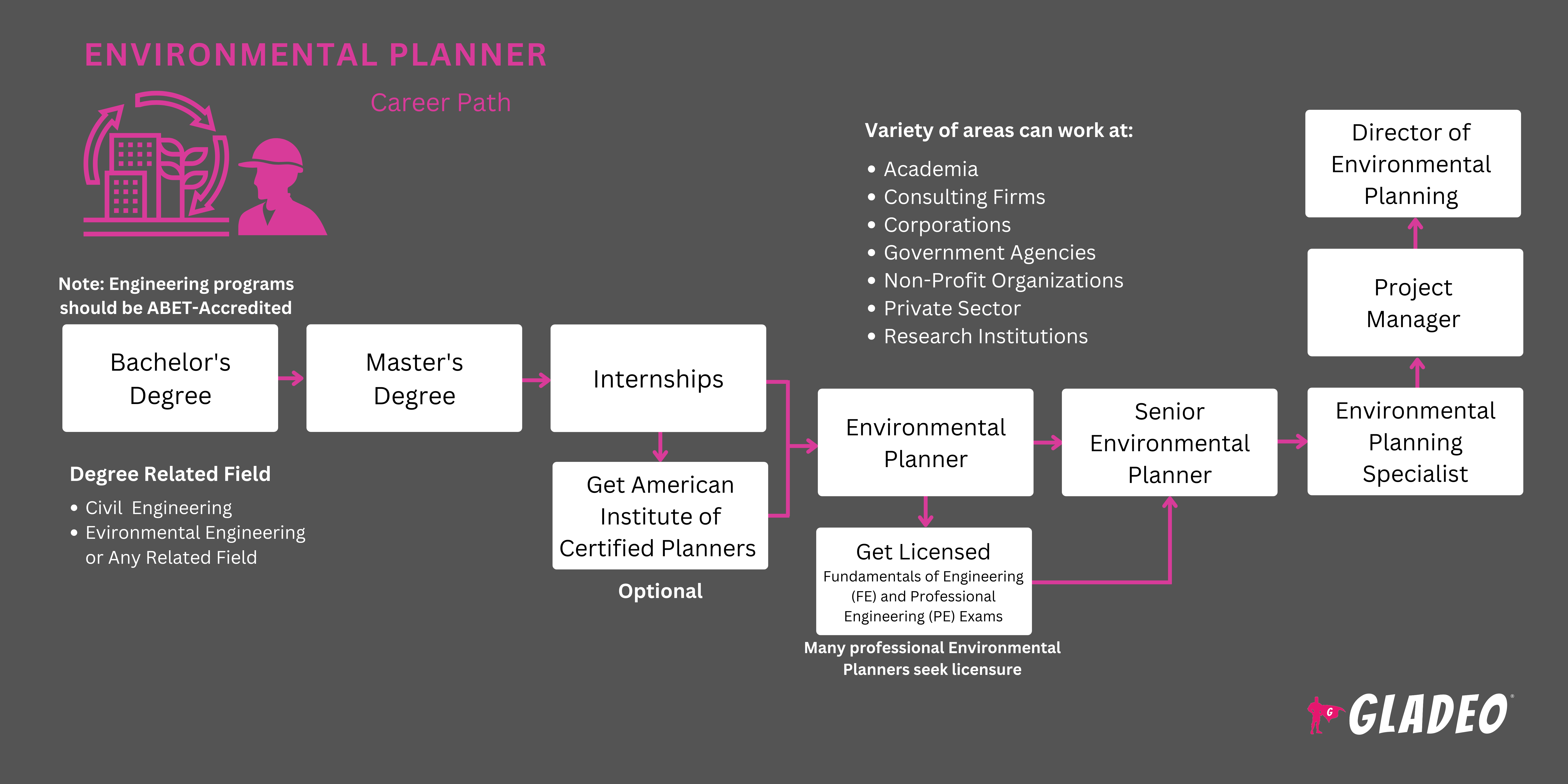스포트라이트
Environmental Planning Specialist, Sustainability Planner, Land Use Planner, Natural Resources Planner, Environmental Impact Analyst, Green Infrastructure Planner, Climate Resilience Planner, Environmental Policy Analyst, Conservation Planner, Ecological Land Planner, Environmental Specialist
Over the long course of human existence, we’ve spent most of our time finding ways to exploit Earth’s abundant natural resources. However, in recent decades, scientists have come to realize we have taken things too far. From air and water pollution to deforestation, our actions have caused so much damage that we’re making our own world less liveable for ourselves and future generations.
To make matters worse, global warming is heating up our atmosphere, contributing to changes in the climate which have led to an increased frequency of natural disasters. For all these reasons, a new career field has emerged in an effort to save the planet — Environmental Planning! Environmental Planners are sustainability experts who work closely with governmental agencies and private organizations to help mitigate further negative impacts on our increasingly fragile environment. Their important work protects everything from plant and animal life to our own quality of living, by saving our air, water, and land from harmful pollution.
- Working in a sector devoted to helping the environment
- Potentially saving lives and improving the quality of life for communities
- Gaining experience in a sector primed to grow in the coming years
근무 일정
- Environmental Planner jobs are usually full-time with most work done indoors. However, some jobs involve physically visiting sites where environmental improvement plans are being utilized. This may include trips to facilities involved with drinking water, wastewater, soil, or even landfills.
일반적인 업무
- Analyze areas of natural resources and assess risk
- Review potential environmental impacts of proposed construction projects
- Manage or analyze environmental planning projects and budgets
- Work closely with architects, contractors, and government officials
- Visit project sites to ensure compliance with regulations and policies. Oversee work in some instances
- Aid in the facilitation of permits acquisition
- Gather and study technical data
- Generate reports with graphics or images, as needed
- Maintain documentation
- Assist with business matters such as Requests for Proposals, Requests for Information, Departments of Transportation proposals, and others
- Review National and State Environmental Policy Act (NEPA and SEPA) guidance
추가 책임
- Report findings internally and to applicable agencies
- Stay up-to-date on environmental laws, codes, regulations, and pertinent studies
소프트 스킬
- Ability to objectively monitor and assess the performance of people, systems, and equipment
- Commitment to quality assurance
- 충돌 해결
- 비판적 사고
- Customer service skills
- Detailed-oriented
- English proficiency
- Ethical and environmental mindset
- Research-oriented
- Safety-minded
- Sound judgment and reasoning
- Strong verbal communication and listening skills
- 팀워크
기술 능력
- Ability to understand blueprints, technical plans, and drawings
- Comfortable working outdoors
- Physical fitness and dexterity
- Regulatory knowledge
- Familiarity with project management software
- Governmental agencies
- Private companies and organizations
Environmental Planners work both indoors and outdoors. At times, they may experience situations of conflict if an employer is eager to have a construction project done but there are environmental risks that jeopardize those plans. Environmental Planners have to be mentally resilient and able to maintain their objectivity as they perform their duties diligently, especially in times when there are disagreements or disputes. First and foremost, it is their duty to ensure compliance and uphold the rules designed to protect the environment.
There seems to be an endless array of manmade dangers pummeling our planet on any given day, exacerbating environmental and climate change-related woes. A few hot ecological priorities have been grabbing the attention of Environmental Planners in recent years.
Among these is the desire to boost renewable energy sources like solar and wind power, while trying to cut back on coal. At the same time, the government continues to push for an overall reduction in energy consumption, in part by encouraging the development of more efficient technology and practices.
Environmental Planners may also expect to work on finding ways to increase plastic recycling to help decrease sea pollution. Another water-related area of concern is human waste management, with health hazards piling up around the globe as water-borne illnesses spread. A lesser known source of problems is cement, which emits ~8% of the world’s total of carbon.
Environmental Planners are often naturalists who appreciate the beauty of our diverse yet fragile planet. In their younger days, they may have enjoyed being outside doing physical activities, but might have noticed how human behaviors have affected nature’s ecosystems in negative ways. These are people who want their work to make a noticeable difference on our world!
- Environmental Planners should hold at least a bachelor’s degree in a suitable field, such as civil or environmental engineering. Engineering programs should be ABET-accredited
- Lots of students complete a master's in planning, environmental planning, or environmental management
- Other major options include environmental science, environmental management, sustainability, or regional planning
- Common classes may include:
- Anthropologic areas
- Design
- Ecology
- Environmental law
- Geology
- Hydrologic systems
- Interior design
- Land management
- Landscape planning
- Math
- Preservation and restoration
- Rural and urban development
- Sociology
- Statistics
- Sustainability
- Water movement
- Students may wish to tailor their courses to match an area of specialization
- Internships can provide valuable hands-on experiences where students can learn while working for a company or agency
- Optional certifications such as the American Institute of Certified Planners credential can make graduates more competitive for jobs
- Many professional Environmental Planners seek licensure by passing the Fundamentals of Engineering (FE) and Professional Engineering (PE) exams
Students seeking an engineering degree should look for programs that are ABET-accredited. Ideally, your program’s environmental faculty should have strong backgrounds in their field, including practice work experiences.
U.S. News & World Reports lists several well-ranked environmental policy and management college programs. While the list isn’t all-inclusive, it may serve as a solid launch point for your search.
- math, geology, sociology, statistics, design classes, and any electives that relate to the environment
- Gain practical work experience through apprenticeship opportunities at Apprenticeship.gov
- Consider volunteering on local Habitat for Humanity projects that may involve environmental considerations
- Get in the habit of reading the hard stuff! Educate yourself through books, magazines, online articles, studies, and policies
- Watch related videos on YouTube and other sites to learn more about the Environmental Planning field
- Find professional organizations that offer educational and network opportunities (see Recommended Websites below)

- Job portals like Glassdoor, Indeed, or SimplyHired are often the best starting points to find jobs
- Ask your college program manager or school’s career services staff for help. They may have direct connections to local recruiters!
- Screen job ads carefully to ensure you meet requirements and have the right experience
- Check out Environmental Planner resume templates for ideas about your own resume
- Focus your resume on relevant work and academic experiences and skills, and try to quantify data when you can
- Keep your social media presence professional, because employers look you up online
- Practice mock interviews and review sample Environmental Planner interview questions
- Talk to former supervisors or professors to see if they’ll serve as personal references
- Environmental planners usually start in entry-level positions and work their way up through hard work and learning everything they can
- Knock out any additional coursework or training your employer suggests
- Become proficient with the equipment and systems you work with, and study manufacturer-provided materials
- Become NABCEP-certified, and/or complete optional core and advanced certifications when you have the minimum experience needed
- Obtain state licensure, as applicable
- Talk with your supervisor about promotions to project supervisor or manager
웹 사이트
- American Geosciences Institute
- 미국 공인 플래너 협회
- 미국 기획 협회
- American Rivers
- Ecological Society of America
- Environmental and Water Resources Institute
- Environmental Science Associates
- Institute of Hazardous Materials Management
- Journal of the American Planning Association
- National Environmental Health Association
- National Oceanic and Atmospheric Administration
- Planners Network
- Planning Magazine
- 생태 복원 협회
- Society of American Foresters
- Society of Wetland Scientists
- UCAR
도서
- Land-Use Planning for Sustainable Development, by Jane Silberstein M.A. and Chris Maser
- NEPA and Environmental Planning, by Charles H. Eccleston
- The Environmental Planning Handbook: For Sustainable Communities and Regions, by Tom Daniels
The world needs Environmental Planners on the frontlines, helping to ensure our planet is safeguarded against harmful hazards. However, for those with a general interest in the field but who want to consider other options, here’s a short list of related alternatives:
- Brownfield Redevelopment Specialists and Site Managers
- Cartographer
- Conservation Scientists
- Environmental Scientists and Specialists
- Geographer
- Industrial Ecologists
- Photogrammetrist
- Range Managers
뉴스피드

주요 채용 정보

온라인 강좌 및 도구








